IWGB at Cofely GDF-Suez
Angel Square, Islington, London. Tue 28 Jan 2014
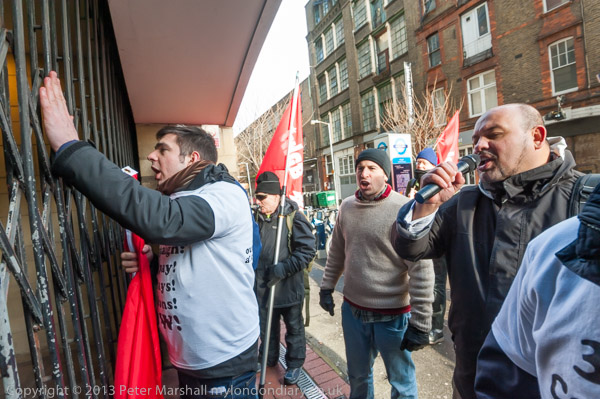
The gates to Angel Square were locked as the IWGB
arrived
more pictures
Text about this is below
IWGB in Royal Opera House
Royal Opera House, London. Tue 28 Jan 2014
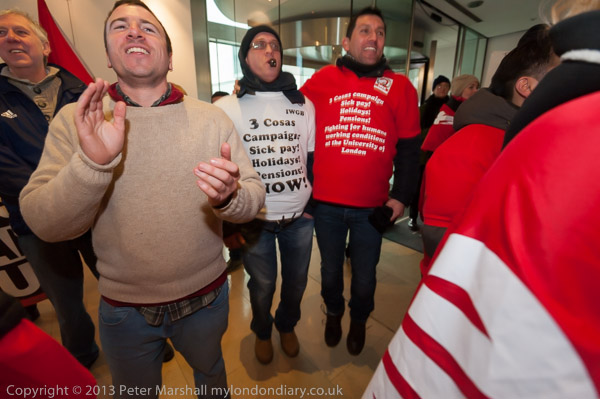
IWGB workers dance in the foyer of the Royal Opera
House
more pictures
Text about this is below
IWGB at Parliament
Parliament Square, London. Tue 28 Jan 2014

IWGB members pose for photograph with MPs John
McDonnell and Jeremy Corbyn (centre back) ; at front right ULU Vice
President Daniel Cooper and IWGB President Alberto Durango.
more pictures
Text about this is below
'3 Cosas' Strike Picket and IWGB Battle Bus
Senate House to Parliament Square, London. Tue 28 Jan 2014
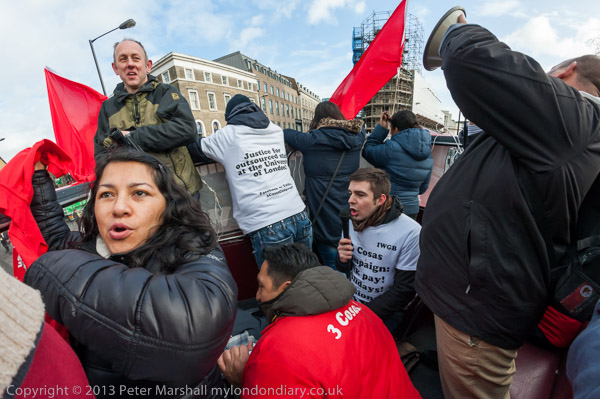
On the IWGB battlebus; at left Sonia Chura, one of
the leaders of the '3 Caosa' campaign
more pictures
Low paid workers at the University of London on the second day of the 3 day strike by the IWGB for union recognition and better conditions took their dispute around London on an open-top battle bus, stopping at key sites for a rally and protests.
For convenience the images from this day of protest are split into four
groups:
'3 Cosas' Strike Picket and Battle Bus
IWGB at Parliament
IWGB in Royal Opera House
IWGB at Cofely GDF-Suez
Pickets from the Independent Workers’ Union of Great Britain (IWGB), including cleaners, maintenance and security staff were outside the University of London Senate House from around 5 am on the second day of the three day strike, and were supported by students and some other staff. I joined them at 9am, and they talked to the one delivery driver who arrived in the next hour and persuaded him to walk away with the parcels he was to deliver, as well as handing out leaflets to many going past or into the university.
The underlying problems is that although these workers work at the university and carry out work essential for the running of the university, the university does not employ them. Most low paid workers - cleaners, maintenance and security staff, catering works and others - at the University of London are no longer directly employed by the University, but work in the University on contracts from contractors Cofely GDF-Suez (who took over the former contractor Balfour Beatty Workplace at the end of last year.) The policy of outsourcing these workers seems largely intended to evade the responsibilities of London University towards an essential part of their workforce.
Outsourced workers have been campaigning for several years to be brought back in house, as well as for better pay and conditions of service, and they have made some progress, achieving the London Living Wage and, following a two day strike in November the gained considerable improvements in sick pay and holiday entitlement. But their conditions, particularly over pensions are still considerably inferior to their fellow workers employed directly by London University.
Relations between the University, the employers and the workers are difficult as the University and Cofely GDF-Suez have refused to recognise the IWGB, to which most of the workers belong, and will not talk to them about problems and negotiate. Although few of the low-paid workers are members of Unison, this is still the only union recognised by the employers. The IWGB and the 3 Cosas campaign have been able to communicate with them largely through a series of demonstrations and the November strike, and gaining union recognition is the key demand of the current strike.
Union recognition is particularly important in the case of workers currently employed at the Garden Halls of residence in central London, which the university intends to close this summer. The IWGB wants these workers to be given priority for vacancies that arise elsewhere in the university, with preference being given to those with the longer periods of service. Although this would seem fair and sensible, the Cofely GDF-Suez management has refused any cooperation with the IWGB over these redundancies.
When I arrived, an open-top bus was parked in the entrance to the Senate House car park, with large banners on it supporting the '3 Cosas' and IWGB protest, and around an hour later most of the strikers and supporters boarded this 'battle bus' to go on a tour of various sites in London, with just a small picket remaining. The sun shone on the workers as the bus drove away, followed by a group of student supporters on bicycles. I was on the upper deck taking photographs as the workers waved their red IWGB flags, chanted and listened to IWGB Branch Secretary Jason Moyer-Lee, Branch Chair Henry Lopez, President of the Independent Workers of Great Britain Alberto Durango, Branch Vice-Chair and leading member of the 3 Cosas Campaign Sonia Chura and University of London Union Vice-President Daniel Cooper as they used a powerful public address system to address the public and workers about the fight for union recognition for the IWGB and comparable conditions of service with directly employed University of London workers for outsourced workers at the university. In between the various speeches and chants, including some in both Spanish and translated into English, there was loud music to draw attention and also to keep the strikers happy.
The first call by the bus was at the University's Garden Halls of residence a short drive away in Cartwright Gardens, where the bus stopped for some speeches to the many who could be seen watching from inside the halls. One-way streets and prohibitions on right turns lead to a lengthy drive to get to the offices of The Guardian, passing through many busy streets where people turned to look and listen to the strikers, and there were many waves of support with some cars hooting and many people stopping to photograph the bus as it went past. The bus passed the Unison headquarters on Euston Road in both directions, to booing from many of the workers, some of whom left Unison in disgust as they felt the were not supporting the demands of low-paid workers, and as we passed the second time, one of the IWGB flags was caught in the branches of a tree and left flying in front of the Unison building.
By the time the bus reached The Guardian, it was running too late to stop, and it continued on to Parliament Square - again having to take a lengthy route, which eventually brought it past Trafalgar Square and down Whitehall, where the passengers made a great deal of noise. The bus did a complete circuit of Parliament Square and then stopped outside the Supreme Court for everyone to hurry off. As the last of them were stepping onto the pavement, a police officer came to talk with the driver; he asked him why he had chosen to stop there, and got the reply that it was where there was a bus stop. Which was true and seemed reasonable, but fortunately the bus was ready to drive off.
The strikers and their supporters marched down the side of Parliament Square and stopped on the pavement outside the entrance to Parliament, where they had arranged to meet Labour MPs John McDonnell and Jeremy Corbyn. There was a brief rally there, with addresses by both the MPs, (and a short message of support from Andy Burnham.) They posed for photographs with the two MPs and then marched towards the Embankment, stopping for another picture in front of Parliament. At this point there was the first shower of the day, and we sheltered briefly under the arcade in front of Portcullis House before crossing the road to board the bus again on the Embankment.
The bus then went on to stop just around the corner from the Royal Opera House (ROH), where everyone kept quiet as we approached the building and then rushed in. Although there were security and police around apparently expecting a visit, they failed to stop everyone coming in. IWGB members working there have voted for a strike in the middle of next month for the London Living Wage and union recognition, including the date of the BAFTA awards there on 16 Feb, which the IWGB intend to picket and some prominent figures have already stated they would not cross the picket line.
Although a majority of the cleaners at the ROH are now in the IWGB, the management there are refusing to recognise or talk with the union, preferring to deal with Unison. One of the people who met the protesters in the lobby introduced himself as the Unison Health & Safety rep and told the IWGB President and the other protesters that the ROH had already agreed that the cleaners will get the Living Wage, though so far the cleaners have not been told this. If the ROH recognised and talked with the IWGB the cleaners would know what was happening.
Back on the bus, the next stop was at the Angel Islington, where Cofely
GDF-Suez (who took over the former contractor Balfour Beatty Workplace
in December) has its offices. Again police were already present and here
as the workers and supporters arrived metal gates were locked across
both the entrances to Angel Square, and the protest took place in
Torrens Place outside the gates. From here the bus was going on to
Elephant & Castle for a late lunch and I left it for the long
journey home.
'3 Cosas' Strike Picket and Battle Bus
IWGB at Parliament
IWGB in Royal Opera House
IWGB at Cofely GDF-Suez
'3 Cosas' Strike Picket
Senate House, University of London. Mon 27 Jan 2014
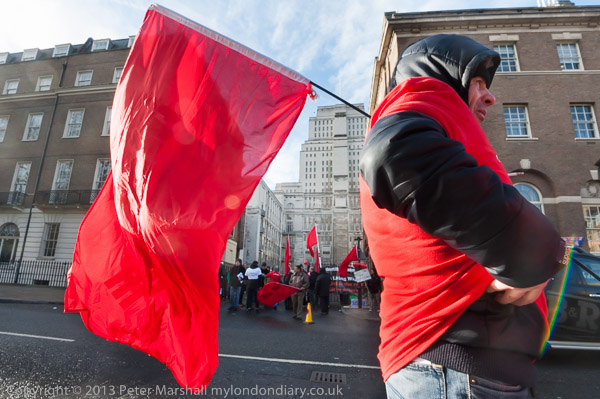
Bright winter sun makes a 'rainbow' as a cleaner
holds a IWGB flag
more pictures
Low paid workers at the University continued their '3 Cosas' campaign for sick pay, holidays and pensions with a 3-day strike, calling for recognition of the IWGB trade
Pickets were outside the University of London Senate House from around 5 am at the start of the three day strike, and I joined them for around an hour in mid-morning. The pickets from the Independent Workers’ Union of Great Britain (IWGB), including cleaners, maintenance and security staff were supported by students and some other staff. The picket will be there tomorrow and Wednesday, handing out leaflets and a daily newspaper about their campaign and asking people not to cross their picket line.
The underlying problems is that although these workers work at the university and carry out work essential for the running of the university, the university does not employ them. Most low paid workers - cleaners, maintenance and security staff, catering works and others - at the University of London are no longer directly employed by the University, but work in the University on contracts from contractors Cofely GDF-Suez (who took over the former contractor Balfour Beatty Workplace at the end of last year.) The policy of outsourcing these workers seems largely intended to evade the responsibilities of London University towards an essental part of their workforce.
Outsourced workers have been campaigning for several years to be brought back in house, as well as for better pay and conditions of service, and they have made some progress, acheiving the London Living Wage and, following a two day strike in Novemember the gained considerable improvements in sick pay and holiday entitlement. But their conditions, particularly over pensions are still considerably inferior to their fellow workers employed directly by London University.
Relations between the University, the employers and the workers are difficult as the University and Cofely GDF-Suez have refused to recognise the IWGB, to which most of the workers belong, and will not talk to them about problems and negotiate. Although few of the low-paid workers are members of Unison, this is still the only union recognised by the employers. The IWGB and the 3 Cosas campaign have been able to communicate with them largely through a series of demonstrations and the November strike, and gaining union recognition is the key demand of the current strike.
Union recognition is particularly important in the case of workers currently employed at the Garden Halls of residence in central London, which the university intends to close this summer. The IWGB wants these workers to be given priority for vacances that arise elsewhere in the university, with preference being given to those with the longer periods of service. Although this would seem fair and sensible, the Cofely GDF-Suez management has refused any cooperation with the IWGB over these redundancies.
There were around thirty or fourty people at the Russell Square gates
to Senate House while I was there, and a small group at the Malet St
gate. The daily newsletter that was being handed out gave information
about the picket. Although trade unionists generally respect the picket
lines of other unions and refuse to cross them, this reported that the
Senate House Unison rep and crossed the picket line this morning,
telling the striking workers "I don't believe in strikes!" It
seemed a very strange comment for any trade unionist, and her own union,
Unison, will be taking strike action next week as a part of the Higher
Education pay dispute.
more pictures
'Axe the Bedroom Tax - No Evictions.'
Peckham & Camberwell, London. Sat 25 Jan 2014
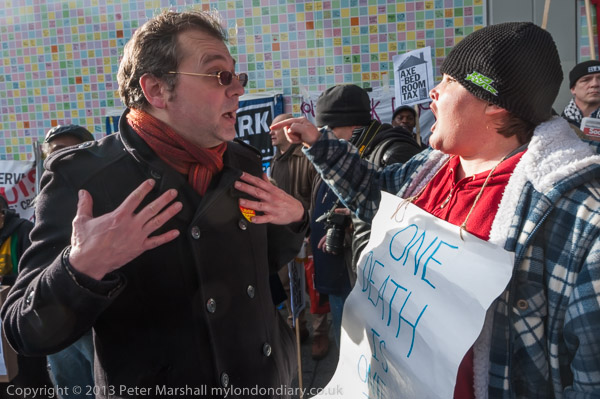
Paula Peters of DPAC tells Southwark Cllr Richard
Livingstone exactly what she thinks of the council's actions
more pictures
A march and rally by Southwark Benefit Justice Campaign called for the unfair bedroom tax which hits those least able to pay to be scrapped, for an end to benefit cuts and for Southwark Council not to evict tenants unable to pay the tax.
Around 150 people met for the march in Peckham Square, where there was a short rally with several speakers. Among them was Southwark Labour councillor Richard Livingstone, Cabinet member for finance, resources and community safety. He was the subject of some robust heckling over the council's failure to oppose the implementation of the Bedroom tax, and in particular about it sending eviction orders and taking to court a number of those who had been unable to pay. After repeated questioning he made a statement that those who were unable to pay and were talking to the council would not be evicted, which would appear to signal a change in council policy.
After his address, and while other speakers continued the rally, Cllr Livingstone engaged in some heated arguments with some of the protesters, in particular with some from Disabled People Against Cuts, about Southwark Council's actions.
Nationwide it is estimate that perhaps 80,000 households face eviction over the bedroom tax, and for many the future is bleak. If evicted they are unlikely to be able to find property in the private rented sector they can afford, and the cap on housing benefit means that in high cost areas such as London and much of the South East rents cannot be covered. People in low paid work in London will simply be unable to find anywhere to live.
As people have realised the true impact of the bedroom tax, public opinion has turned against it - with around 6 out of every 10 people wanting it scrapped. It is a tax that particularly hits many of the disabled and others with special housing needs. Ed Miliband has recently announced that the next Labour government will abolish the bedroom tax, and many are calling for Labour local authorities such as Southwark to adopt a firm “No evictions” policy.
The marchers then set off to walk the mile along the main road to Camberwell Green, with people - including the bridesmaids from a wedding party and several bus drivers - waving and gesturing their support, and car drivers hooting along the way. Although the march was a relatively small affair, it clearly had a great deal of support from the local people.
On Camberwell Green there was a longer rally, with speeches from
members of most of the groups supporting the event which included
Southwark Trades Union Council, Southwark UNISON, Southwark UNITE,
Southwark NUT, Lambeth and Southwark PCS, Southwark Group of Tenants
Organisations, Southwark Defend Council Housing, Southwark Disabled
People Against Cuts, Southwark Pensioners Action Group, Southwark Save
Our Services, Peoples’ Republic of Southwark. Among the more memorable
speeches were those by Roger Lewis of the Lambeth Disabled
People Against Cuts and Unison and DPAC activist Paula Peters,
as well as the Rev Paul Nicolson of Taxpayers Against Poverty
and Denise McKenna of the Mental Health Resistance Network.
more pictures
'Free the Primates' Anti Vivisection Coalition
MHRA, Victoria, London. Fri 24 Jan 2014
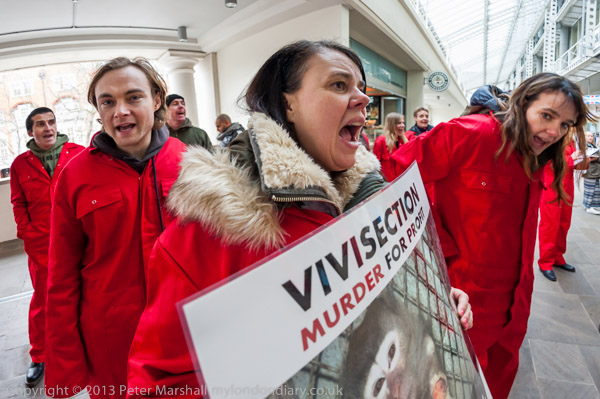
Woman with poster 'Vivisection - Murder for
Profit' shouts 'Free the Primates'
more pictures
Anti-Vivisection Coalition protesters in red boiler suits with the message 'Against Animal Testing' held a noisy protest outside the Victoria HQ of the MHRA, calling for an and to testing on primates carried on at its NIBSC labs at Potters Bar.
The Anti Vivisection Coalition (AVC) is an organisation which sees itself as representing on behalf of animals of all species in laboratories through peaceful protests, education, legislative change and strategic campaigns. AVC believes that animals are living beings who have a right to live without fear and pain.
They want all experimentation on animals to stop. There are 4.1 million 'procedures' each year on animals in the UK, and also many thousands of animals born in the breeding farms for laboratory use are killed because they do not meet the requirements. Many experiments involve the infliction of pain on animals, often without any pain relief as this might affect the studies, and they are housed in cramped cages, and for some experiments strapped so they are unable to move.
Around 50 protesters held a noisy but peaceful protest in the pedestrian walkway in front of the main entrance to the offices of the Medicines and Healthcare products Regulatory Agency (MHRA) of which the National Institute for Biological Standards and Control (NIBSC) in Potters Bar, just outside London, is a part.
Some held banners or posters against animal experiments, and they shouted noisily led by two young women on powerful megaphones, calling for an end to animal experiments and for the primates at Potters Bar to be freed.
Last December the AVC protested outside the NISBC labs in Potters Bar, and also launched a petition calling for an end to the use of primates.
In a statement the NIBSC say that they play "a vital international role with the World Health Organisation in ensuring that essential biological medicines like vaccines and blood products are as safe and effective as possible" and that every batch of diphtheria, whooping cough, HiB, tetanus and polio vaccine has to be tested to make sure it is both safe and effective. They have set over 95% of the world’s International Standards for accurate dosing and consistent manufacture of vital biological medicines and "carry out vital research to support elimination of global diseases such as polio, hepatitis C and AIDS."
They insist that their work with animals "is performed in full compliance with stringent UK legislation, and we have been praised for our high standards of animal welfare by Home Office Inspectors, who regularly make unannounced visits." They say that the only animals that they import are a special strain of mice that they now use in place of primates for testing the safety of polio vaccines, and that "Our staff are committed to looking after the animals to the best of their ability, are very well trained and are proud of the work they do."
They are indeed proud to state: "We believe that NIBSC has done more than any other laboratory in the world to reduce the dependence on animals for medicines testing" and say that they "minimise the use of animals in our work as much as possible" and claim "NIBSC is an international leader in developing alternatives to Replace, Reduce and Refine animal testing (the 3Rs)." Nine new non-animal tests that they have developed have been accepted by the European body regulating the testing of medicines in the past ten years and "have reduced the numbers of animals used in medicines testing labs by tens of thousands, and we are currently working on several more 3Rs projects."
The NIBSC says its use of animals in testing has "almost halved
over the last 10 years with most of that decline in the last 5 years.
The use of primates has declined much more sharply by almost 90% over
the last decade."
more pictures
Solidarity with African Refugees in Israel
Israeli Embassy, Kensington, London. Wed 22 Jan 2014
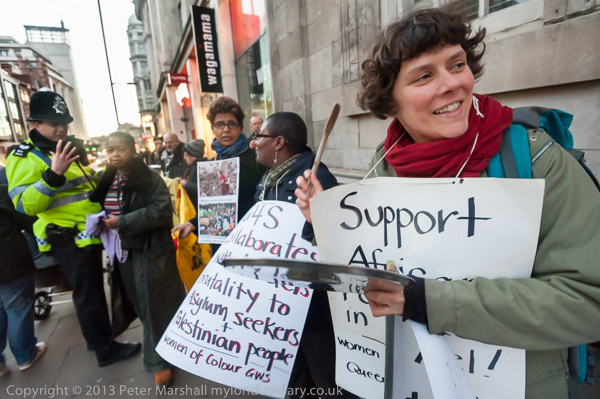 Some
protesters brought wooden spoons and pan lids to make a lot of noise
Some
protesters brought wooden spoons and pan lids to make a lot of noise
more pictures
People came to protest at the Israeli embassy in response to a call by African asylum seekers for international action to support their protests against the arbitrary arrests, imprisonment and inhumane treatment of refugees inside Israel.
Tens of thousands of African asylum seekers have been protesting on the streets of Israel since the beginning of the month, holding mass rallies against their treatment by the Israeli authorities.
This follows a crackdown after the amendment in December of Israel's laws against refugees, enabling anyone entering the country without proper papers to be held for up to a year without trial, and for those who are already in the country to be held in infinite detention. The detention facility for them in the Negev desert, like many other Israeli prisons, is run by the private security company G4S.
Most of the refugees in Israel come from the Sudan and Eritrea, both areas of extreme conflict with brutal regimes that have killed many of their citizens. Although there are around 50,000 refugees currently living in Israel, only a few hundred applications for refugee status have been processed. Most of the others can only keep alive by living illegally on the streets and taking whatever work is available in the 'black economy', with constant exploitation and threat of arrest.
The recent strike by those working as cleaners, cooks, dishwashers and other low paid workers brought many restaurants, hotels and businesses to a standstill. Over 20,000 of them rallied in Rabin Square with banners saying 'We are refugees, not criminals' and demanding their rights.
The protest in London was one of many today following a call by the
African Asylum Seekers Community in Israel for international solidarity
in protests outside Israeli embassies around the world. Protesters came
together around 50 metres from the Israeli embassy which is on a private
street where protests are not allowed. Police tried to move them away
across the road to where there were pens for the protest, but after they
pointed out that they were on a public pavement decided to allow the
protest to continue there, insisting that most of the pavement was kept
clear to allow people to walk past. After some time they sensibly
brought some cones from across the road to allow people to pass the
growing protest in safety.
more pictures
Students march to protect Education
London University & Holborn. Wed 22 Jan 2014
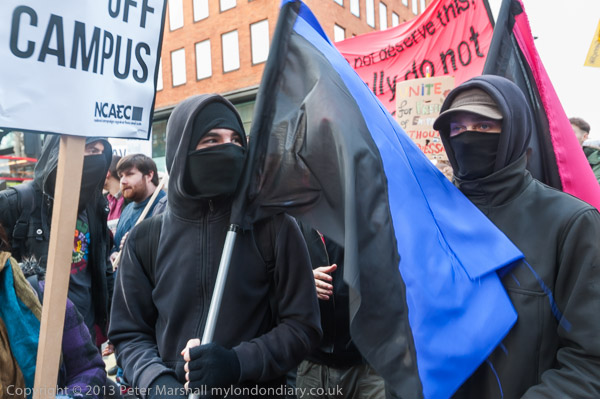
Protesters visited Holborn Police station on their way to the Royal
Courts of Justice
more pictures
London University students marched in a peaceful protest to show they intend to keep up their protests for democratic, public education free from exploitation and police violence and to support university workers on strike this week and next.
Several hundred students listened to speeches by ULU President Michael Chessum and representatives of the lecturers who are taking action this week and cleaners at the University of London who go on strike for the first three days of next week, as well as a student who spoke about police violence, in particular against the black community.
The students then left for a tour of various key sites in the area, walking past both sides of Senate House and then on to the University & Colleges Employers Association in Tavistock Square. Here a handful of protesters with placards and anarchist flags made a brief token entry into the lobby, accompanied by rather more photographers and videographers, and some paint was thrown at the outside of the building, hitting several protesters and photographers.
The marchers then went to Holborn Police station, where they protested loudly against police violence and in particular at the execution by police of Mark Duggan, calling for Justice.
From there they marched to Holborn Station and down Kingsway to Aldwych and the Strand, ending the march with a short rally outside the Royal Courts of Justice. Both these and the Police station were guarded by a line of police, who had kept a discreet distance away out of sight while the marchers were around the university area.
At then end of the rally there were several suggestions as to what
students might do, with Alfie Meadows suggesting that they go on to
Covent Garden Opera House nearby, where next month the cleaners are also
going on strike for a living wage and decent conditions of employment.
more pictures
Release Margaretta D'Arcy Now!
Irish Embassy, London. Wed 22 Jan 2014
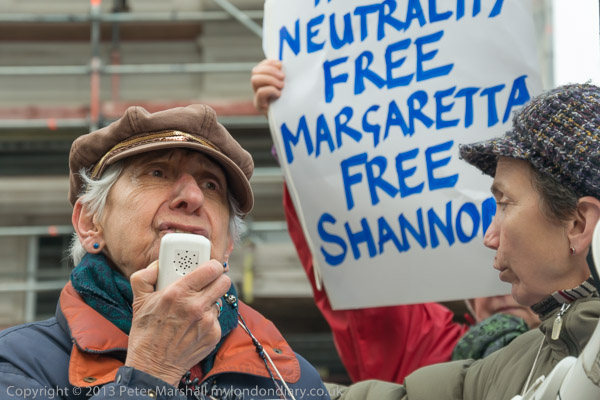
Selma James calls for the release of Margaretta
D'Arcy
more pictures
Protesters at the Irish Embassy handed in a petition demanding the immediate release of anti-war activist and writer Margaretta D'Arcy, 79, jailed for 3 months for protesting against the use of Shannon’s civilian airport for US wars.
The protest was called for today as D'Arcy is due to appear in court. She has been jailed for lying down on the runway at Shannon in a peaceful direct action by members of Galway Alliance Against War against the use since 2001 of Shannon by US war planes in violation of Irish neutrality.
Ms D’Arcy, a veteran of the Women's Peace Camp at the US airbase on Greenham Common, is 79 and is undergoing treatment for cancer and suffers from arthritis in her neck. An an acclaimed writer, actress, playwright and film director, she is the widow of author John Arden. She has been arrested many times for her peace protests.
Almost 50 people came with banners and posters for a protest outside the Irish Embassy in London calling for her immediate release, from organisations including the Global Women's Strike, Troops out of Ireland, Winvisible, Women of Colour, Kilburn Stop the War, Labour Caribbean Solidarity, Payday Men's Network, Irish Republican Prisoners Support Group and others.
Many of those who came spoke at the event, including Selma James and several others from Global Women's strike, Gerry Downing, Michael Kalmanovitz of the International Jewish Anti-Zionist Network and Austin Harney of the PCS and Campaign for the Rights and Actions of Irish Communities. Several of the speakers, particularly Cristal, Kay and Sian from Global Women's strike talked about how Margaretta had been a powerful member of the group at the 'Yellow Gate' at Greenham Common, whose protests had eventually led to the legal challenge and closure of the US Base with its cruise missiles.
Between the speeches, protesters chanted slogans: 'Free Margaretta,
Free Shannon' and 'US Military out of Ireland, US Military out of the
World'. At the end of the protest a petition was delivered to the
Embassy calling for the immediate release of Margaretta D'Arcy.
more pictures
No More 'Benefits Street' Channel 4
Channel 4, Victoria, London. Mon 20 Jan 2014
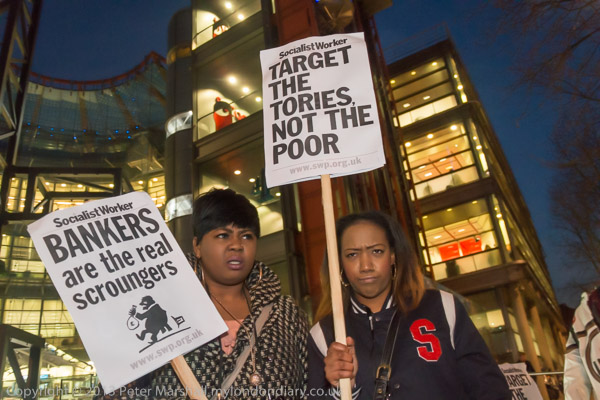
Two young women pose with placards outside the
Channel 4 HQ on Horseferry Rd
more pictures
A small protest at Channel 4 condemned the media exploitation of communities which denigrates the vulnerable who receive welfare benefits in series such as Benefits Street which creates controversy without exposing the underlying issues and truth.
Protesters complain that while making a spurious claim to be objective, Benefits Street acts to reinforce many widely promoted myths about claimants that the government uses to promote its policies to cut welfare benefits.
Few of those on benefits are the criminals or scroungers that the media concentrate on. Most are people in difficult times, often because of disabilities or domestic problems and are trying hard to make a living. Almost a fifth of people in working age households are unemployed, but only 2% of them have never had a job.
Newspapers headline benefit fraud, but it accounts for less than 1% of benefit expenditure and is estimated to be around a tenth of the amount of benefits that people who are eligible for fail to claim. The loss from tax evasion and doubtfully complex tax avoidance are several orders of magnitude higher still.
Most people who rely on benefits are actually in work, doing essential but low paid jobs. Almost a million housing benefit claimants are workers.
Benefit Street does not set out to give a true image of benefit claimants, and certainly not a true picture of those who live on James Turner St or other similar streets throughout Britain. It is about entertainment, misrepresenting real people living in difficult circumstances for the sake of profit and TV careers. Perhaps coincidentally, this particular area was the subject of detailed research in the period just before the programme was made, and this gives a more detailed and very different view - as one of the researchers has said, he just couldn't recognise the street from the TV programme.
There were fewer than expected at tonight's protest, with none of the expected support from the Unite union, apart from Unite Community member the Rev Paul Nicholson. Letters from him about the programme have appeared in both The Guardian and the Times.
The protest began on the pavement outside Channel 4, watched from the slope up to the entrance by a couple of security guards who occasionally came to shoo off those who encroached on Channel 4 property.
After around 45 minutes the protesters discussed what to do next. Some left at this point and a small group decided to try and go inside the Channel 4 building. They moved quickly up the slope, walking around the security guards but found that the doors were locked against them. They protested for a few minutes in front of them, then walked down back to the pavement. More went home at this point.
Channel 4 had called the police when the protesters came on to their property, and ten minutes later two police cars arrived. Officers went up to talk to the security, then a couple came down to talk to the remaining handful of protesters. Some simply ignored them, and others laughed when the police asked who was in charge. Clearly nobody had been in charge at what had been a rather unorganised event, and after a few more inconclusive questions the officers went back to sit in their cars.
The few remaining protesters stood around talking on the pavement and
more left, leaving just four there when five minutes later as I was
standing at the nearby bus stop a police van, siren blaring, sped around
the corner and then braked sharply to a halt at the side of Channel 4.
It was followed shortly be another, again travelling at high speed. I
stopped to see what would happen. Absolutely nothing. The four remaining
protesters by then remaining said goodbye to each other and walked away.
more pictures
Staines Evening
Staines, Middlesex. Sun 19 Jan 2014
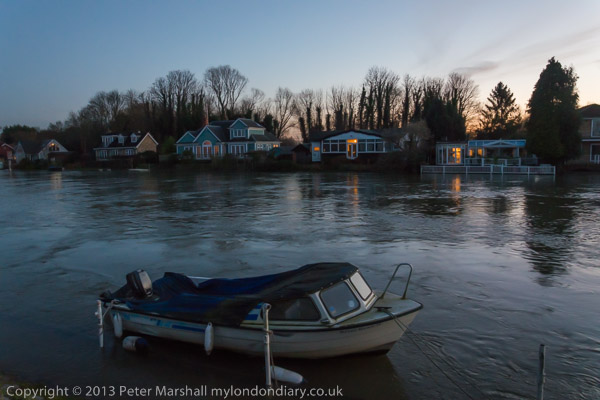
River Thames well after sunset
more pictures
I don't do sunsets. There are just too many bad pictures of them
already. Dawn's the same, even worse because you have to get up early
for it. But I had my camera with me when we went to check that the river
was still going down, and the light was interesting, so I took a few
pictures. The river is still quite a few feet above normal levels, and
there was almost no drop over the weirs at Penton Hook. And still a lake
on the fields behind the lock.
more pictures
Israeli Gay Tourism Pinkwashing
Villiers Street, London. Sat 18 Jan 2014
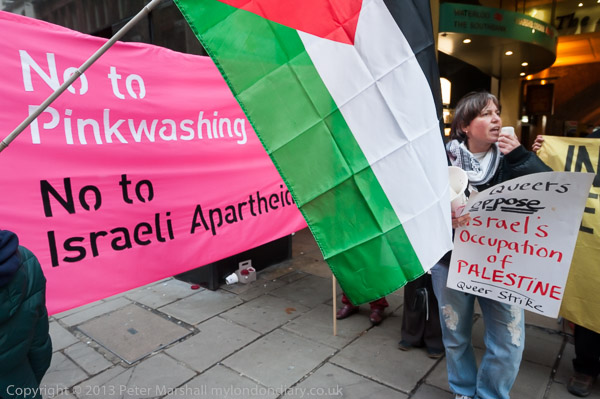
There were protests organised by Queer Strike and by 'No Pinkwashing'
more pictures
Protesters outside a beach-themed LGBT tourism promotional event denounced the 'pinkwashing' which claims Tel Aviv to be "one of the best gay cities in the world" as an attempt to divert attention from human rights crimes against Palestinians.
One of the organisers of the event had earlier confirmed on video that they had received money from the Israeli Tourism Board for their participation in the Gay Star Beach Party LGBT tourism event. The board hope to persuade gay tourists to holiday in Tel Aviv, but the protesters asked people to boycott Israel until ends human rights abuses and recognises the Palestinians' right to self-determination and complies with international law.
The picket at the entrance to the arcade containing the club where the event was being held handed out 'No Pinkwash' cards calling on people not to attend the event, and claimed success in getting a number to turn away. Perhaps the information on the card will also persuade more that they should not holiday in Israel until they end the occupation of Palestine, dismantle the separation Wall and lift the siege on Gaza, recognise the right of return of Palestinian refugees and give full equality for Palestinians who live inside Israel.
The card listed five reasons for LGBT tourists not to fall for what the call the Israeli "pinkwashing" and go to Israel:
- the military occupation of the West Bank, East Jerusalem and Gaza since 1967, with over 100 illegal Israeli settlements on land stolen from Palestinians;
- the violence against Palestinian children, hundreds of whom are arrested each year and held in military detention without access to lawyers, mainly for alleged stone-throwing;
- the inhuman siege of Gaza, blocking import of food, fuel and medical supplies and preventing the repair of many homes destroyed in the 2008-9 invasion by Israel;
- the ethnic cleansing of Palestinians from their homes and land which began in 19438 and still continues, creating millions of refugees;
- the apartheid system of roads reserved for Jewish Israelis, the apartheid wall and the many check points involving long waits and searches for Palestinians.
The protest was also against Israel’s racist treatment of African people following the protests in Tel Aviv last week by 30,000 African asylum seekers and refugees demanding that all African refugees imprisoned in Israeli prisons and detention centres be freed and for recognition of their rights as asylum seekers and refugees.
The protest had been started earlier in the day by members of Queer Strike, Women of Colour and the International Jewish Anti-Zionist Network, and was joined by the time I arrived by people from the 'No Pinkwashing' campaign, set up to oppose the PR technique of 'pinkwashing' - using opposition to homophobia to legitimise Israel and undermine support for Palestine who had drawn attention to the event. Later some of those who had been at other pro-Palestinian protests earlier arrived, including some from Haringey Justice for Palestinians and London Palestine Action.
There was strong support from people passing on the street for the protest, with just a couple of minor incidents. The security guard from the arcade came to tell the protesters they must not block the entrance to the arcade when all the protesters had moved their for a photograph, and later one man who appeared to be very drunk came and argued with protesters, pushing one of the roughly and threatening a number of others before finally moving off.
There seemed to be very few people going into the beach party while I
was there, and there were reports that it was very poorly attended.
more pictures
Peace vigil for Syria
Trafalgar Square, London. Sat 18 Jan 2014
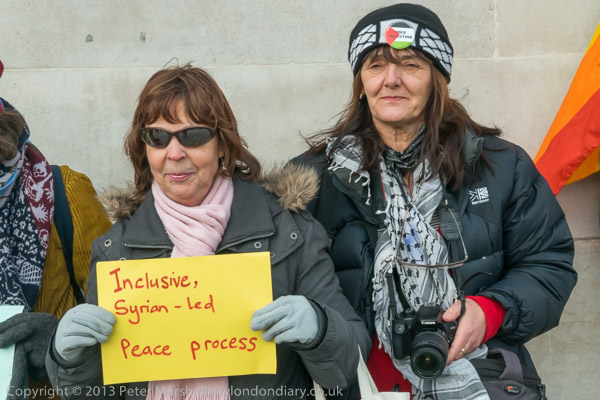 Geneva
2 will not be inclusive or Syrian-led and will not lead to peace
Geneva
2 will not be inclusive or Syrian-led and will not lead to peace
more pictures
Ahead of the Geneva 2 peace talks next week, Syria Peace & Justice held a peace vigil in Trafalgar Square calling for immediate humanitarian ceasefires and the release of all political prisoners and an inclusive Syrian-led peace process.
Syria, Syria Peace & Justice, Geneva II, Geneva, peace talks, vigil, Trafalgar Square, London, humanitarian ceasefire, peace vigil, humanitarian aid, besieged communities, political prisoners, detainees, arbitrary detention, Syrian-led, peace process, Syrian women, civil society, moderate opposition, peace activists, peace-loving, pacifists,
The small group of protesters held the vigil on the North Terrace of
Trafalgar Square, standing in line against the wall below the National
Gallery with banners, posters, peace flags and a lit candle.
The recently formed Syria Peace & Justice Group say that the Geneva talks, "whose agenda is being set by major foreign powers like the US and Russia, are unsatisfactory. On the Syrian side, only the government and a single opposition group, the Turkey-based SNC, have been invited." They call for "an inclusive Syrian-led peace process that includes strong representation from Syrian women, Syrian civil society organisations and various moderate Syrian opposition groups."
More people were expected to arrive later, coming from the Gaza vigil
at the Israeli embassy, but I had to leave for another event. Their
presence was obviously resented by one of the street performers who now
seem to regard the area as their own private performance space, although
they had taken care to set up their vigil well away from him.
more pictures
Anonymous March For Freedom UK
Trafalgar Square to Parliament Square, London. Sat 18 Jan 2014
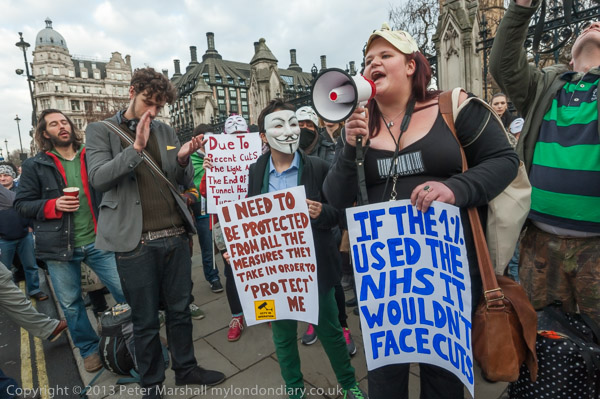
The march ended with a rally outside Parliament
more pictures
Following a large protest on November 5th, Anonymous supporters arranged another wide-ranging protest against privatisation, cuts, environmental and other issues, calling for the people to claim the country back from those who are destroying it.
By the time I arrived, almost half an hour late there was a crowd of over a hundred people, many in 'Anonymous' masks in one corner of Trafalgar Square, listening to various people who took advantage of the microphone to address the group. Among them were many had taken part in Occupy London, and on the outside of the group were a number of police, including some Police Liaison Officers in their blue bibs as well as a FIT team with a police photographer.
There was an entertaining mime by a man dressed as Charlie Chaplin with various suitable protest props which got considerable laughter and applause, entertaining both the crowd and the police.
Soon after someone suggested to the people with the microphone that it was time to start the march, and the suggestion was put to the crowd who agreed. It didn't really seem like a march as some people rushed to the far corner of the square and others slowly followed them, but after being held up at the traffic lights to cross the road, and shepherded by police the group finally got together and walked down Whitehall at a fairly rapid pace.
More police had appeared and walked on either side as the group made its way down the southbound carriageway. The protest had been organised as a peaceful and family-friendly event, and this was the case, as they marched past Downing St with nothing more than a few shouts and rude gestures and on to Parliament Square.
Here it became obvious that this was a protest without leaders, and with no real idea where they were going or what to do. The police made several suggestions as to where they might go, but eventually they simply stopped where they had got to, on the roadway close to the vehicle entrances to the Houses of Parliament in Parliament Square.
After a couple of minutes police succeeded - with the protesters cooperation - in getting them to move partly onto the pavement so that traffic could be directed past them and the rally which was now taking place.
I stayed for a few speeches. One speaker stressed the importance of networking and of making connections between others at the event and elsewhere to grow the movement. Another gave an impassioned plea about the NHS, reminding us that if the 1% including those who run our country used the NHS they would not be privatising services and closing hospitals.
It was unclear what the protesters intended to do next, and there was a
suggestion that they might stay where they were and party in Parliament
Square, but I left shortly after this was made, walking past a small
crowd of police vans to do so.
more pictures
Gaza Massacre 5th Anniversary
Israeli Embassy, Kensington, London. Sat 18 Jan 2014
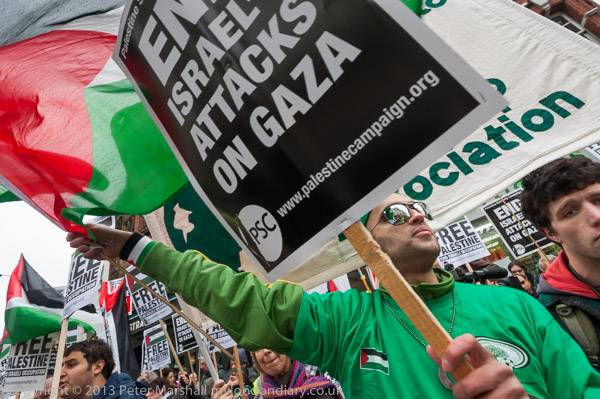 Protesters
were in a pen on Kensington High St opposite the private road with the
embassy
Protesters
were in a pen on Kensington High St opposite the private road with the
embassy
more pictures
A vigil by around 500 close to the Israeli embassy marked 5 years since the end of the 2008/9 massacre in Gaza, Operation Cast Lead, in which around 1,400 Palestinians were killed, many of them unarmed civilians.
Several hundred packed the protest pen set up by police opposite the entrance to the private gated and guarded road containing the Israeli embassy. Many carried Palestinian flags and wore traditional Palestinian scarves and badges showing their support for Palestine, and there were many placards and banners against Israeli apartheid and the occupation of Palestine, and calling for a boycott of Israeli goods.
For almost an hour the crowd kept up a barrage of chanting, with one person in the crowd shouting out a slogan that was then picked up and repeated by the crowd, and when that had finished another person shouted out another slogan calling for justice for the victims of Israel’s massacre and against the ongoing siege on Gaza. There were then a series of speeches.
Among those taking part were a number of Palestinians and Jews, who
have been prominent in calling for a boycott of Israeli goods. The
protest was supported by many groups, including the Palestine Solidarity
Campaign, the Palestinian Forum in Britain, British Muslim Initiative,
Campaign for Nuclear Disarmament,
Stop the War Coalition, Jews for Justice for Palestinians, Friends of
Al-Aqsa UK, Liberal Democrats Friends of Palestine, War on Want, Unite
the Union, Public and Commercial Services Union, Amos Trust and ICAHD
UK.
more pictures
Focus E15 Mothers Party Against Eviction
East Thames Housing Assn, Stratford, London. Fri 17 Jan 2014
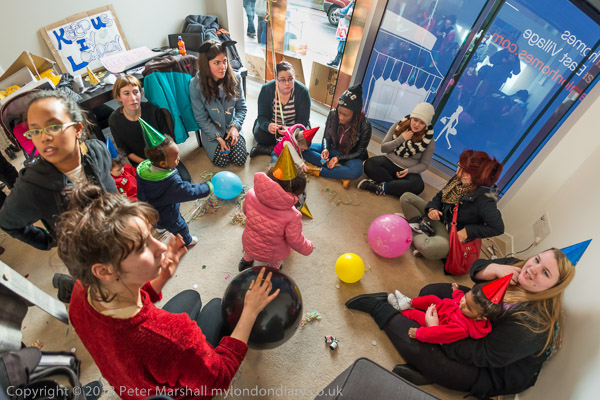
The childrens' party in the East Thames Housing
Association show flat
more pictures
Mothers threatened with eviction after Newham Council removed funding from East Thames's Focus E15 Foyer occupied the housing association's show flat and held a childrens' party, discussing their situation with officers of East Thames.
A group of the mothers from Focus E15 Foyer met with supporters on a street corner near the offices of East Thames housing association close to the centre of Stratford, East London, and after a brief explanation from three of the mothers of what was happening to them walked down the street and into the large foyer there.
Inside they posed for a photograph for one of the local newspapers before going into the show flat at the front of the offices facing the street and beginning to hold a party inside there.
The flat isn't huge - though rather bigger and in much better condition than the rooms in the Focus E15 Foyer where the women are living - and it soon got very crowded, although a number of the protesters stayed outside on the street with banners and placards, handing out leaflets to people walking by and using a megaphone to explain why the mothers were protesting.
After a few minutes one of the East Thames staff who has been meeting the mothers and handling their case came into the party and talked to the mothers and the protesters.
He told the mothers that East Thames would not evict them from the Foyer, despite the fact that they have already received notices of eviction, and that the housing association was committed to allowing them to remain until satisfactory accommodation had been found. But he said it was the council's responsibility not that of the housing association to rehouse them.
Many present pointed out the East Thames has large numbers of homes - including many on the former Olympic site -but he replied that they were unable to allocate affordable properties directly, but had to work with Newham council. He seemed surprised to hear that Newham had made offers involving rehousing away from London, in Hastings, Birmingham and elsewhere, away from friends, families, colleges, nurseries and support networks, and stated that East Thames intended to see them rehoused in London.
These offers of rehousing away from London were also in private rented accommodation, which offers little or no security of tenure and also leaves tenants at the mercy of often unscrupulous or uncaring landlords. Research by Shelter had demonstrated the systematic failing of families by the private rented sector.
Although he also agreed with the mothers that their current accommodation was no fit place to bring up children and was at pains to appear generally sympathetic there seemed to be no real meeting of minds. Later the Group Chief Executive of East Thames, June Barnes, arrived and talked to the mothers in a similar vein.
Legislation under successive governments has attacked the whole basis of social housing in Britain, with Thatcher's 'the right to buy' severely eroding the social housing stock and the whole idea has been largely lost, replaced by a minimal 'affordable housing' programme which has been woefully inadequate and at least in London, unaffordable for most - priced as it is at 80% of market rent - particularly with the effect of the bedroom tax and benefit caps.
Newham Council, led by Mayor Robin Wales, seems to have turned its back on the low income residents of the borough. It has been attempting to redevelop one of its more popular council estates, the Carpenters Estate, a short walk from where the protest was held. Street after street of properties on the estate have been empty, boarded up for several years and made uninhabitable by council workers, despite an extensive local campaign to keep the estate open and get rid of all the existing occupants.
Newham has block after block of new high rent flats in Stratford, and what must be one of the largest ongoing developments of expensive flats in the country on and around the former Olympic site. Yet these new developments have only small numbers of 'affordable' units, with the council apparently wanting to attract high income earners to the area, while trying to send those it has a responsibility to house to distant areas of the country. One of the mothers said she had been told by the council "you can't afford to live in Stratford." They say that what used to be a social housing policy is now a policy of social cleansing. There are plenty of empty homes in Newham for those with money.
The mothers from Focus E15 are not the only people affected by these policies, but they have taken a stand. They run a protest stall on Stratford Broadway every Saturday as well as regular public campaign meetings, and a Facebook page and have attracted a great deal of public support.
One of the mothers, Jasmin Stone, commented:
‘Mothers of Focus E15 are still fighting, we have been battling East Thames and Newham council for our right to stay in London. We are still strong and will not give up. Newham council and East Thames have continuously blamed each other for what is happening and failed to take responsibility. We have met with Robin Wales who was very negative towards the campaign and stated that we need to be realistic and that there are no properties in the area.’
The party in the show flat was continuing as I left. Later the mothers
took their protest to the nearby Newham Council offices.
more pictures
Shepperton & Ballard
Old Charlton Lane, Shepperton, Middlesex. Tue 14 Jan 2014
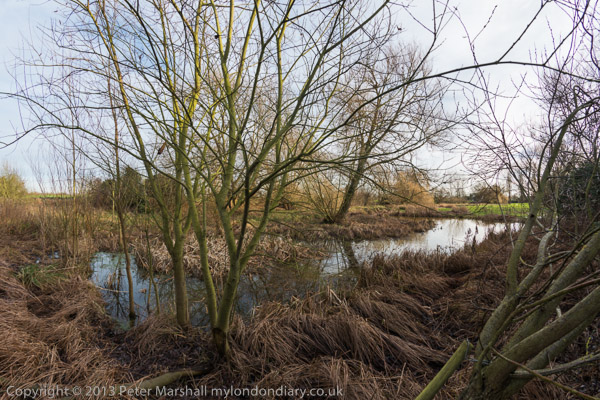
Swampland at the top of Old Charlton Lane
more pictures
One of the greatest English post-war novelists, J G Ballard chose to live in a rather ordinary semi-detached house in Shepperton, a few hundred yards from the last station on one of the minor railway lines out of Waterloo. When he moved in 1960 he was earning a living as assistant editor of a scientific journal, but he found the job and the long commute to London (about an hour to Waterloo) took up too much of his time, and after publishing his first book, gave up the job to become a full time writer in January 1962. From then until his death in 2009 the Shepperton house was his home and he brought his three children up there on his own after the tragic early death of his wife. After his death the house was put on sale and is now privately owned.
When he moved to Shepperton the road on which he lived used to go to the nearby village of Charlton, but in 1968 work began on the M3 motorway and the section which cuts off the road around a quarter of a mile to the north of his home opened in 1974. It is perhaps no co-incidence that his novel 'Crash' was published in 1973. Other aspects of this suburban village and the wider area around are also reflected in some of his novels.
Cyclists and pedestrians can still make their way to Charlton, through
a swampy area around the River Ash and over the motorway on a footbridge
with spiral approaches at each end. On the far side is a nature reserve
and then Nutty Lane continues to Charlton.
more pictures
Benefits Street Protest at Love Films
Holborn, London. Mon 13 Jan 2014
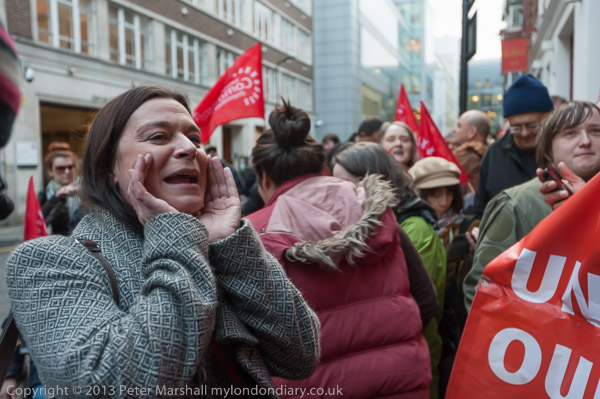 A
woman leads shouting of slogans outside Love Films
A
woman leads shouting of slogans outside Love Films
more pictures
Protesters outside Love Films in London called for an end to Benefits Street, a Channel 4 series they claim misrepresents people on benefits, propaganda which demonises and stitches up people who deserve public sympathy and support.
The protest was organised by Unite Community and Disabled People Against the Cuts and supported by other groups which represent those hardest hit by the current austerity programme including Kilburn Unemployed Workers Group, Barnet Alliance for Public Services, Southwark Benefit Justice Campaign and Taxpayers Against Poverty.
Around 50 protesters met outside the Holborn offices of Love Films, and protested for a couple of hours on the afternoon before episode 2 of the programme was to be aired and at the same time as MP Michael Meacher was leading a backbench debate on welfare and poverty.
After a few minutes of shouting slogans calling for Love Films to stop their hate campaign against the poor there were short speeches from many of those present, including Sean McGovern, chair of Unite's national disabled members' committee, Andy Green of Disable People Against Cuts and the Reverend Paul Nicolson of Taxpayers Against Poverty.
Many of those who live on 'Benefits Street' (James Turner Street in Birmingham) have been appalled at the way their street has been presented in the programme, including both those who are working and those who are out of work, and there have been hundreds of complaints to Ofcom and Channel 4.
Residents taking part in the programme were told it would portray life on a street where three-quarters of the people were on benefits, but the program has been edited to focus almost entirely on those on unemployment benefits - something which represents a small fraction of the welfare bill, and half of those on benefits are actually in work. The main story line in the first programme concentrated on one entirely unrepresentative resident who lived on the earnings of his petty crimes.
Among those who has publicly complained about the bias of the programme
is Dame Anne Begg MP, Chair of the House of Commons work and pensions
committee. There have also been complaints from around a hundred welfare
charities. On Twitter, columnist Owen Jones posted: 'As for well-off
TV producers trying to further their career by turning the poor
against the poor: You. Are. The. Pits.'
more pictures
More Flooding
Staines & Laleham, Middlesex. Sun 12 Jan & Tue 14 Jan 2014
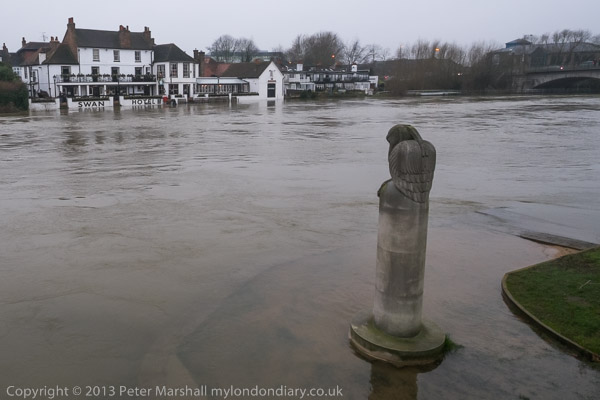
Water was high in the Thames at Staines, covering
parts of the tow path
more pictures
The river had been rising for some days and we had been keeping an eye on it as it rose up the banks and came across the towpath. I came back one day from taking pictures in London to hear that around noon we had received an automated flood alert call from the Environment Agency, warning us of likely flooding in the near future.
We live a quarter of a mile from the Thames, but flooding here comes up from the drains. According to the Environment Agency's maps, we are at severe danger of flooding from the small ditch that runs at the bottom of our garden, Sweeps Ditch, but that just shows how out of touch with reality they are, as it is over 40 years since water has run naturally in it. I've tried to get them to correct the maps, but without success; its an error that is costing me hundred of pounds a year on house insurance.
Our house has never yet quite flooded, though in 1947 there was water under the floorboards. In 2003, when we last got a flood alert, the water came up halfway across the road in front of our house, but we stayed dry then. But it was a close thing.
We took the warning seriously, and moved everything of value that was within a foot or so of the floor to higher levels. Sweeps Ditch was dry except for a few puddles (the council hadn't turned off the pump, but its outflow had been blocked by rubbish and it was pumping water instead over a riverside car park), and should we flood would be a good route for water to drain away. There was some local flooding, but we were high enough to escape it - just a foot or two makes all the difference. A few days later we got another call, telling us the danger was no longer imminent, and we felt considerable relief. Though it will probably be a couple of weeks before we get everything back in its normal place again.
I was busy photographing other things in London and didn't get out to
cover the floods, though a few miles away they were bad. I took a few
pictures of the river close to where we live - and the riverbank was
busy with others with cameras.
Most of the flooding seems to have been from Surrey rivers - including
the Mole and the Wey, and large areas a few miles away at Chertsey were
under water. But in Staines the Colne seemed to have little more water
than in most wet periods, unlike in 2003 when all of Staines Moor was
under water.
more pictures
Sisi Supporters Oppose Boycott
Egyptian Embassy, London. Sat 11 Jan 2014
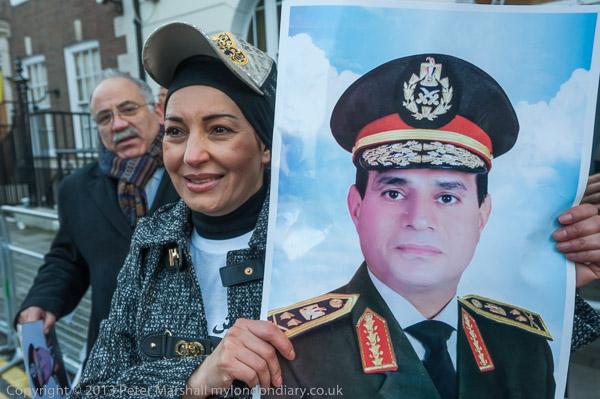
Supporters outside the Embassy where Egyptians
were voting in the referendum hold up pictures of Sisi
more pictures
Egyptians gathered in front of the London Embassy as Egyptians came to vote to oppose a protest by the Free Egypt Alliance which was urging voters to boycott the constitutional referendum.
The supporters of Sisi occupied the pavement in front of the embassy, and a number of people coming out from the embassy also expressed their support of the military deposition of Morsi and the firm action against the now-banned Muslim Brotherhood and the transition to a new constitution for Egypt.
Many of those taking part held up large portraits of General Sisi. The group was considerably smaller than those across the road, but made a considerable noise, shouting at the largely Muslim crowd opposite, and making 'V' for Victory signs in response to their four-finger Rabiaa salutes. There were numerous Egyptian flags being worn or displayed by both sides.
Several Egyptian groups, including supporters of the now banned Muslim
Brotherhood, are urging a boycott, but although many Egyptians have
concerns over the human rights abuses under the imposed military rule, a
majority support the new constitution and hope for improvement once it
is adopted.
more pictures
Free Egypt Alliance Urge Vote Boycott
Egyptian Embassy, London. Sat 11 Jan 2014
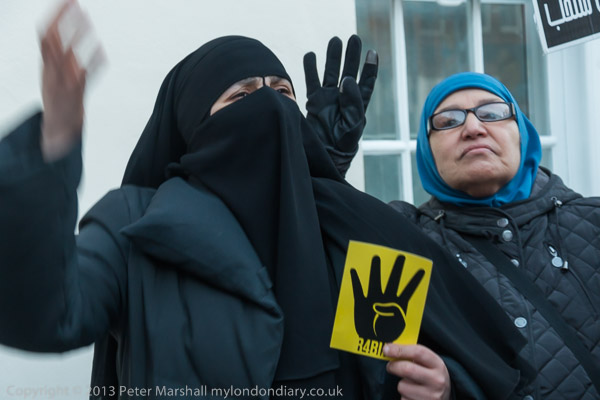 A
woman in Muslim dress holds up a card with the Rabia salute
A
woman in Muslim dress holds up a card with the Rabia salute
more pictures
Supporters of the Free Egypt Alliance protested opposite the London Embassy against the ousting of President Morsi by the Egyptian military and the many people who have been killed in the crackdown against the now banned Muslim Brotherhood. They called on Egyptians going into the embassy to vote in the constitutional referendum urging them to boycott it.
Former President Morsi was deposed following widespread protests calling on him to step down after failing to deliver on its commitments to democracy and with the support of a wide range of groups, and the transition roadmap has been endorsed by Egypt’s highest Islamic and Christian Coptic authorities, prominent liberal politicians, and the Salafist Nour party.
The heavy crackdown against supporters of the deposed President Morsi has led to a great deal of disquiet over the activities of the interim government imposed by General Abdul Fattah al-Sisi and led by Interim Prime Minister Hazem Beblawi, particularly among supporters of the Muslim Brotherhood, which has recently been declared a terrorist group after the car bomb outside a government building in Mansoura on December 24th. Many members of the Brotherhood have been killed or arrested and charged with serious offences and the Brotherhood was banned in September.
Around a hundred members of the Free Egypt Alliance carried out a noisy protest opposite the Egyptian Embassy in London today, shouting across the road at a smaller group of Egyptians supporting Sisi. Some held placards giving details of some of the individuals killed by the regime during the suppression of the Brotherhood, including press photographer Ahmed Assem who worked for the official newspaper of the political wing of the Brotherhood, the Freedom and Justice Party's Al-Horia Wa Al-Adala and was shot while filming a sniper firing at protesters during prayers in Cairo - his video ends as the rifle is pointed at him.
Many also carried flags, placards, balloons or gloves with the rabaa (or rabiaa or r4bia) four=finger sign, and repeatedly made this during the protest. The sign came into use after the sit-in by supporters of Morsi in the Rabaa al-Adawiya square last August (rabaa is Arabic for 'fourth') and since then has been adopted for use at rallies by supporters of Morsi.
One man wearing a Getdeen sweatshirt with the message 'Islam Rules
Everything Around Me' crossed the road to argue with the Egyptians in
front of the embassy, but was quickly stopped by police and persuaded to
go back to the other side.
more pictures
Repeal Indian anti-Gay Law
Indian High Commission, London. Sat 11 Jan 2014
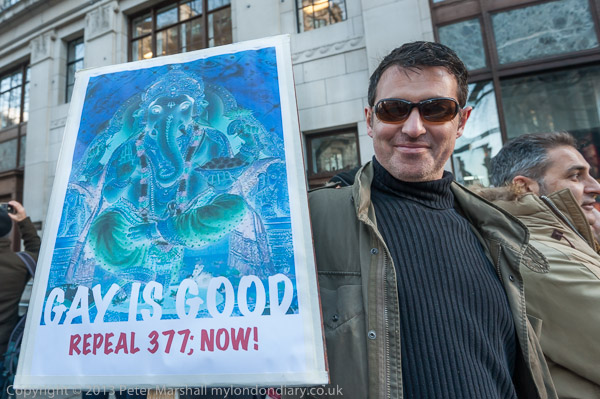 Ganesh
on a poster - Gay is Good, Repeal 377; Now! calling for the repeal of
colonial anti-gay law
Ganesh
on a poster - Gay is Good, Repeal 377; Now! calling for the repeal of
colonial anti-gay law
more pictures
Protesters at the Indian High Commission urged the Indian Parliament to repeal Section 377 of the Indian Penal Code, dating back to 1861, which criminalises homosexuality following a Supreme Court ruling that it still applies.
Section 377 of the Indian Penal Code was introduced under British rule in 1861 and criminalises all sexual activities "against the order of nature" and was carried over into Indian law at Independence in 1947.
It was declared unconstitutional with respect to sex between consenting adults by the High Court of Delhi on 2 July 2009, but that judgment was overturned by the Supreme Court of India on 11 December 2013. They held that amending or repealing Section 377 should be a matter left to Parliament, not the judiciary.
The protest was a relatively quiet affair while I was there, with
stewards in pink scarves and less than a hundred protesters, among them
Peter Tatchell and a number of Indians as well as others from the LGBT
community. Some of the protesters who had placards including Peter
Tatchell left the pen for photographs a few yards away in front of the
main entrance to the Indian High Commission.
more pictures
12 Years of Illegal Guantanámo Jail
Trafalgar Square, London. Sat 11 Jan 2014
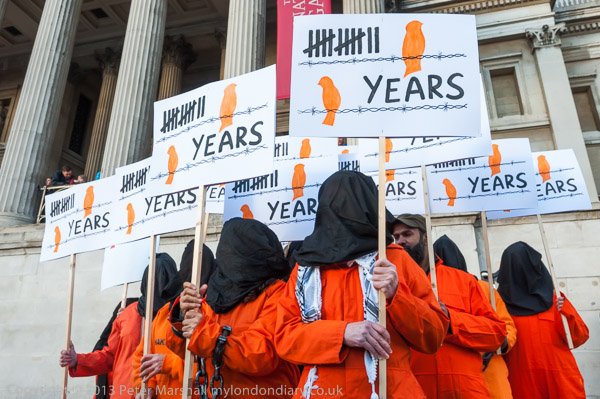
Protesters with placards outside the National
Gallery
more pictures
Human rights campaigners in Trafalgar Square in jumpsuits and black hoods demanded the closure of the Guantánamo Bay prison camp on the 12th anniversary of its setting up, and for the immediate release of prisoners, including Londoner Shaker Aamer.
At the start of the protest a block of 20 people in orange jumpsuits
and black hoods held up placards with orange birds perched on barbed
wire and
and a tally showing twelve years on the pavement in front of the
National Gallery. They then changed placards for a further photo-call
with placards calling for the release of Shaker Aamer, the only British
resident still held in Guantanamo who will have been imprisoned there
and regularly subjected to beatings and other torture for 12 years on
Feb 14th.
Others in the orange suits held banners calling for Shaker Aamer to be freed, and also present were the wife and young daughter of Shawki Ahmed Omar, tortured and imprisoned in Iraq for nine years on false charges.
Aisha Maniar for the London Guantanamo Campaign stated:
"Twelve years on, the prison at Guantánamo Bay remains a stain on the current global landscape. It is unfortunate that it has taken a near-fatal hunger strike by prisoners to remind the world, and Barack Obama, of his promise to close the facility. While a step in the right direction, recently renewed efforts by the US administration to reduce the number of prisoners and close the facility, remain half-hearted."
"Where there is no risk to their safety, President Obama must ensure that prisoners cleared for release are repatriated immediately. In addition, periodic reviews of prisoners must be accelerated to ensure any further releases. Other states must step up their efforts by demanding the repatriation of their nationals and residents."
"The British government can lead the way by using this anniversary to renew its demands for the return of hunger-striking British resident Shaker Aamer to his family in London. The time to act is now. There must be no more anniversaries."
I left shortly after the speeches started, with a crowd of around a
hundred listening to Liberal Democrat MEP for London Baroness Sarah
Ludford. Other speakers at the event were expected to include Jeremy
Corbyn MP, solicitor Louise Christian, Joy Hurcombe of the Save Shaker
Aamer Campaign and representatives from the Green Party, Veterans for
Peace UK, Reprieve, Amnesty International and WISE Up for Chelsea
Manning.
more pictures
Vigil for Bogotá Mayor Petro
Colombian Embassy, London. Fri 10 Jan 2014
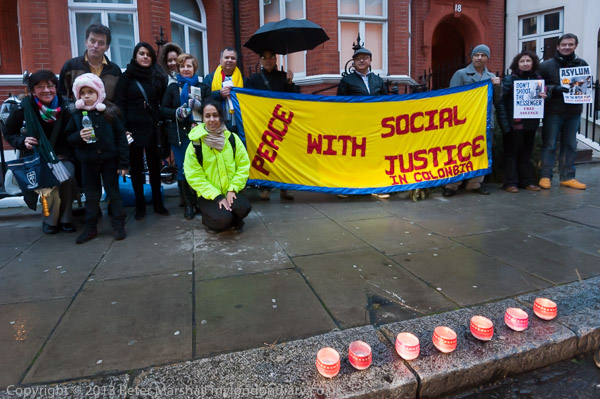
The vigil was just starting as I arrived and took
some pictures in the rain
more pictures
Colombians and other Latin Americans protested opposite the Colombian embassy in last night's rain demanding the reinstatement of the Mayor of Bogotá, Gustavo Petro, whose removal threatens the political left and the democratic process in Colombia.
The protesters say that the decision by the Colombian Attorney General Alejandro Ordóñez to remove the Mayor and ban him from holding public office for 15 years shows that the Colombian government is backing the interests of private capital and denying democracy in the country. It calls into question the whole participation of the political left and democratic forces in playing a part in the peaceful transformation of the country through elections.
The strength of public feeling backing Petro in Bogota led to massive protests there before Christmas, and force the Civil Registry to hold a vote. For Petro to remain as Mayor - and avoid the ban imposed on him holding any political office for 15 years - there has to be a turnout of at least 1.2 million of the around 7.6 million voters in the city, and Petro needs to get 50% of the vote. The vast protests suggest he is likely to do so, but should he fail the case will go to the Costa Rica-based Inter-American Court of Human Rights.
Gustavo Petro was seen as one of the leading figures in Colombian politics, and as Mayor of Bogota is often seen as Colombia's second most important elected office. He ran unsuccessfully for President in 2010, and unless the ban is upheld is likely to run again. The ban came after he had attempted to get the city to take over its waste collections from private companies, which Ordóñez said was a violation of free-market principles.
Peace talks in Havana between guerrillas of the Revolutionary Armed Forces of Colombia (FARC) seemed likely to be about to reach a successful conclusion, but is seen a a serious blow to the chances of reaching a settlement, which very much depends on FARC and opposition parties being given effective guarantees over their participation in democracy in the country. The talks have also been affected by recent revelations about the covert actions of the US CIA, NSA and Pentagon in the internal armed conflict in Colombia. The talks are currently suspended over Christmas and the New Year and should resume on Monday 13th January.
Ordóñez is one of the fiercest opponents of the peace process. Petro has made it clear that he does not want his ban to hold up the search for a peace settlement, and is widely seen as a possible future left candidate for the presidency. There have been protests in Colombia against the ban, and it seems likely that even were the current appeals to fail, if the country returns to open democracy and peace he will be an important figure in its political future.
Petro, a former guerilla who gave up fighting for politics in the 1980s, remains in office pending the result of his appeal against the ban, and has attracted considerable support, even from many opposed to his policies, who see the sentence as excessive for what was a minor mistake in administration. The ban is seen by many as being more about his other actions, such as the banning of bull-fighting and support of same-sex marriages, which have angered right-wing conservatives such as Ordóñez.
The evening protest in London took place in rain, at times heavy which perhaps kept down attendance, though others were still arriving when I left around an hour after the protest had been timed to start. A police officer came over to talk to the protesters, asking if they would make less noise, and after a lengthy and good-natured discussion they agreed to do so. They suggested that they could protest more effectively but cause less disturbance to the neighbours if they were allowed to protest on the pavement outside the embassy rather than across the street, which seemed a reasonable suggestion, but one that was not acceptable to police.
The protest was called by the Movement of Colombian Migration in London
and supported by many other Latin American organisations in London and
elsewhere. I had to leave shortly after the vigil began and others were
expected later.
more pictures
RMT Protest at Tube Cuts
Euston Station, London. Fri 10 Jan 2014
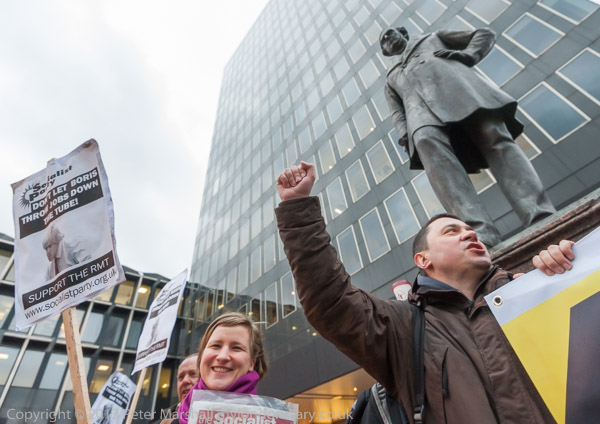
The protesters posed for photographs under the statue of Robert
Stephenson who built the line to Euston
more pictures
RMT members at the protest were on their way to a meeting later in the afternoon where the results of the ballot over action were to be announced. As well as the massive vote in favour of strike action, there were even more members in favour of action short of a strike. RMT's executive is to have a meeting to consider the results and decide on further action.
In a statement RMT General Secretary Bob Crow said:
"RMT members on London Underground have voted by a massive majority for both strike action and action short of a strike in a dispute which is wholly about cash-led cuts plans that would see the axing of nearly a thousand safety critical jobs and the closure of ticket offices at a time when the tube network is under growing pressure from customer demand and needs more staff and not less to ensure safe and efficient operation.
Not only are a thousand posts on the line but staff remaining are going to be forced through the humiliating and degrading experience of re-applying for their own jobs – the same staff who have been hailed as heroes when the tube has faced emergency situations. That is a kick in the teeth for the loyal and experienced tube workforce who have kept services running safely and efficiently under constant pressure from weight of demand and a creaking and under-resourced infra-structure.
These cuts would hit the vulnerable, the elderly, those with disabilities and women the hardest. De-staffing stations, with supervisors running operations three stops down the line on an IPad, would turn the tube system into a criminals paradise where those with violence and robbery on their minds are given a clear run. RMT will work with our sister unions and passenger groups to ensure that tube users understand just what’s at stake as Boris Johnson turns his opportunist election pledges on their head.
Before the Tories start shouting the odds they should take note of the fact that the turn out in this ballot was higher than the last mayoral and GLA elections and the vote in favour massively outstrips anything that those same politicians can even dream of in terms of a popular mandate."
The protest had been announced as a 'flashmob' at Euston's tube ticket office, but that did not happen. Instead the protesters met outside the station in the rain and then decided to hold a static protest at the foot of the statue of Robert Stephenson, Chief Engineer for the London and Birmingham Railway which brought the first main line into London at Euston, just a few yards outside the main entrance to the station.
Fortunately the rain eased off as the protesters held up banners and placards and shouted slogans. Many of the placards were about the failure of London's Mayor Boris Johnson to keep the promise he had made during his 2008 election campaign to safeguard the future of ticket offices on the grounds of keeping passengers safe and secure.
The proposed changes are seen as particularly difficult for elderly and disabled users of the Underground who will be unable to get the help they often need to use the system.
One change that will effect all travellers is the phased withdrawal of the Oyster Card, which is to be replace by contact-less bankcards. While currently any problems over wrong charging are dealt with by London Underground with the bank cards you will have to try and get a refund from your bank.
London Underground is planning to get rid of 750 full time staff in pensionable jobs, and to reassess the grade and pay of others. Although their existing conditions will be protected in the short term, after a few years employees could face huge pay cuts.
Some of the lost jobs will be replaced by outsourced workers on zero
hours contracts on low pay and with poor conditions, and also without
the training and competences of the current workforce. The changes are
simply designed to save money - following the government’s 12.5% cut to
Transport for London’s funding - without regard for the safety and
security of those who travel on the tube.
more pictures
Free Shaker Aamer Vigil
Parliament Square, London. Wed 8 Jan 2014
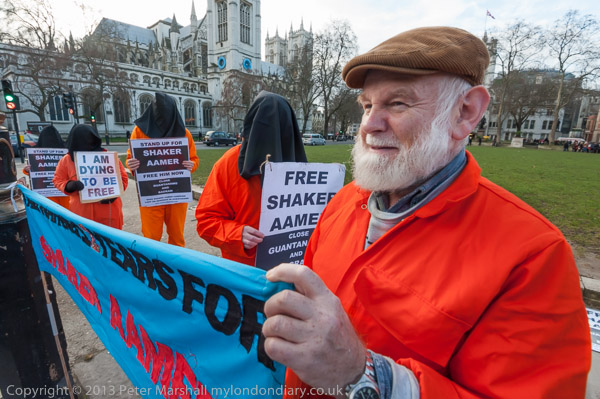
This was the first weekly vigil for Shaker Aamer
in 2014
more pictures
The Save Shaker Aamer campaign mounted its first vigil opposite Parliament in 2014 calling for the Londoner's urgent release. Held there without charge of trial since Feb 14, 2002 he was first cleared for release in 2007.
A dozen protesters in orange Guantanamo-style jump suits and black hoods lined the pavement opposite Parliament with posters and banners, occasionally walking slowly up and down to remind MPs of the need to press the US for his release.
London resident Aamer was kidnapped by bandits in Afghanistan where he was working as a volunteer in humanitarian relief and sold to the US forces towards the end of 2001. After being tortured in Bagram and elsewhere in Afghanistan he was illegally rendered to Guantanamo shortly after it opened, arriving there on Feb 14 2002 (St Valentine's Day.)
There has never been any real evidence against him, never any charge or trial, but he has been routinely subjected to torture both in Afghanistan and at Guantanamo, where his ill-treatment continues. Even now he is being regularly beaten by guards. He was cleared for release over 6 years ago under the Bush administration and again under Obama, but is still held, almost certainly because of the evidence he would give if released about his torture by the US, and the complicity in this of British MI5 agents who interrogated him in Bagram.
Although UK governments have claimed to have pressed for his release, many feel that this is the public face, while in private they have urged the US to keep him locked up and avoid the embarrassment his release would ensue to our security services.
The US is said to be trying to get him released to Saudi Arabia, where
he would almost certainly never be heard of again. He has British
resident status and a wife and four children in Battersea, London. His
youngest son Faris was born shortly after his arrest and has never seen
his father.
more pictures
Against Uganda's Anti-Gay Law
Uganda House, Trafalgar Square, London. Wed 8 Jan 2014
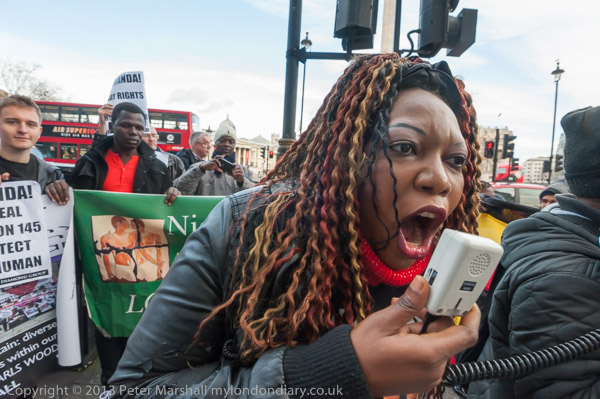
A Nigerian woman supports the protest
more pictures
Human rights protesters including many Ugandans protested at Uganda House urging President Museveni not to sign the draconian Anti-Homosexuality Bill that could condemn many LGBT Ugandans to life imprisonment and to repeal other anti-gay laws.
A crowd filled the pavement outside Uganda House on Trafalgar Square in the protest organised by the African LGBTI Out & Proud Diamond Group and Peter Tatchell Foundation and supported by other groups including Queer Strike, Movement for Justice, Lesbian Gay Christians, Rainbows Across Borders, the RMT, Nigerian LGBTIs and Women of Colour.
The called on President Museveni not to sign the Anti-Homosexuality Bill, (often referred to as the ‘Jail the Gays’ Bill) which was passed by an inquorate Ugandan Parliament on 20 December despite not being on the day's order of business.
The say the Bill "violates the Ugandan constitution, Commonwealth Charter and the African Charter on Human & People's Rights to which Uganda is a signatory. It does not even conform to the human rights check list agreed by Ugandan parliamentarians."
The Bill has been promoted in Uganda as defending religious values, and has been backed by some bigoted right-wing fundamentalist Christians in the US but widely condemned around the world by human rights groups and more moderate Christians as an anti-gay crusade. There were several clergy at the protest and one of them spoke out strongly against it as anti-Christian and inhumane while I was present.
The bill apparently extends the current penalty of life imprisonment for anal sex (a relic from colonial law after Uganda gained independence in 1962) "to all other same-sex acts, even mere kissing and touching. It introduces jail terms of five to seven years for promoting homosexuality, including advocating LGBTI rights or assisting LGBTI people or events."
Also in December the Ugandan parliament passed a Pornography Bill which has also not received Presidential assent. This has vague but sweeping powers and includes the setting up of an Anti-Pornography committee to detect, collect and destroy pornographic materials and will ban the wearing of mini-skirts and other 'indecent' clothing.
Campaigners see these two bills as an attempt to scapegoat the gay community for the many problems of Ugandan society, and in particular corruption and thievery of the ruling elite including most in Parliament.
In November, the European Court of Justice ruled that fear of imprisonment for homosexuality in African countries, including Uganda, is grounds for asylum in EU countries. Our government in January 2013 forcibly deported Jackie Nanyonjo to Uganda, where she died from injuries inflicted on her during the deportation process an on arrival in Uganda.
Despite the European ruling, the UK are still deporting LGBT people to
Uganda where they face persecution - including Prossie N, a 20 year-old
asylum seeker who fled here after years of sexual abuse and rape by her
uncle from the age of 8. After successfully resisting attempts to deport
her in October and November, this lesbian wheelchair user was finally
deported to Uganda in December, where campaigners say she ‘faces certain
persecution and the likelihood of imprisonment and torture’.
more pictures
Thames Path Panoramas
Vauxhall to Wandsworth. Sun 5 Jan 2014
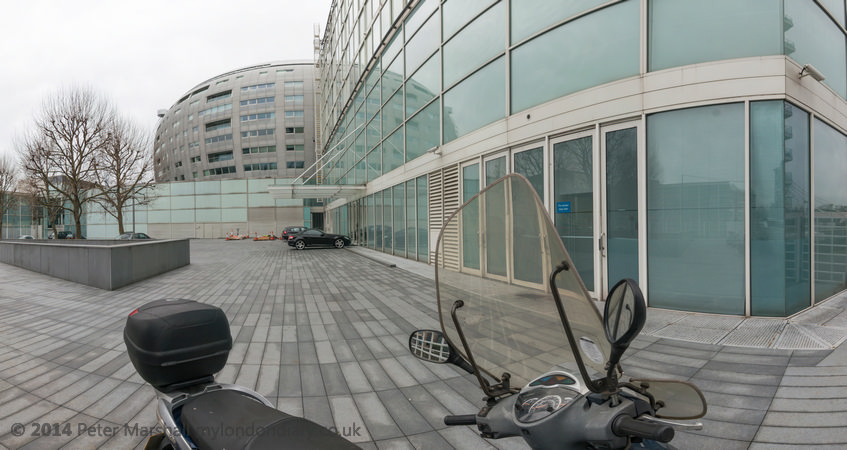 A 143 degree horizontal angle of view in
eqirectangular projection
A 143 degree horizontal angle of view in
eqirectangular projection
more pictures
I spent a few hours on the Thames Path before attending an afternoon film screening working with my latest approach to panoramic photography. All of these pictures use an Equirectangular projection, which I think gives the most natural result for views of around 100-180 degrees. These images mainly have horizontal angles of view of around 110 degrees or 140 degrees, with a few at lower angles.
Usually in photography we make Rectilinear images, but it is often hard to get these to look right at greater than 90 degrees. The Hassleblad X-Pan which I used to use for some panoramas, making them with its 30mm lens worked very much at the limit with its horizontal angle of view of just under 90 degrees.
All of the images on the linked panoramic pages are presented 450 pixels tall. This results in differences in image width, partly because there is some loss when images need to be levelled and then cropped to a rectangular format. The method used to produce the images generally gives an aspect ratio of around 1.9:1, rather lower than the roughly 2.4:1 produced by most panoramic film cameras I've previously used. The images are presented here without cropping other than that required to give the rectangular format.
In future I will probably concentrate on taking images at around 140
degrees. I like the greater sweep of view and the original files are
perhaps a little sharper.
more pictures
Kennett & Avon: Newbury
Woolhampton Lock to Newbury. Thu 2 Jan 2014
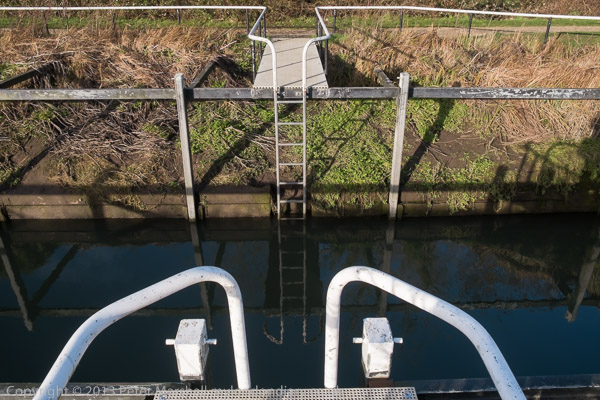
Monkey Marsh Lock, built in 1723 still has its
turf sides - and is an ancient monument
more pictures
We put off our usual New Year's Walk because it was pouring down with rain and instead went on the following day, when the weather was - as forecast - splendid for January, with sun and no rain. There is only one train an hour from Reading to Midgeham Station - which is in Woolhampton, and it was around 11.30 by the time we arrived there. Midwinter days are short, but this gave us a very reasonable four and a half hours for the eight or nine miles we intended to walk.
This part of the Kennet & Avon navigation is based around the Kennet River which sometimes runs along the navigation and at other times on one or event both sides of the canal. It was constructed almost 300 years ago as the Kennet Navigation, and stopped making money in the late 1870s, and in 1926, the Great Western Railway who then owned it tried unsuccessfully to be allowed to close it. But it remained open and in use until around 1950 - the last narrow boat to make the passage from Bristol to Reading was in 1951. The British Transport Commission failed to maintain it properly and large sections became derelict. In 1956 an Act of Parliament suspended the right to navigation but a House of Lords amendment following intensive lobbying called for no further deterioration.
Although restoration by the Kennet and Avon Canal Trust (founded in 1951 as the Kennet and Avon Canal Association) began in 1962, it was not until 1990 that it was fully re-opened and craft larger than canoes (which can when necessary be carried out of the water) could again make the full transit.
We'd chosen to make this walk because no flooding was reported in the area, while routes by the Thames were mainly under water. We found only a few places where there was a little water we had to wade through, and managed to keep our feet dry. But we almost had to abandon the route shortly before reaching Thatcham, where several trees had blown down in the storm a couple of weeks earlier and the towpath was completely blocked. There didn't seem to be any way around, but after breaking off some of the smaller branches we managed to climb under some trees and over others and continue on our way.
We sat down to eat our lunchtime sandwiches by the turf-sided Monkey
Marsh Lock, a scheduled ancient monument, and one of only two remaining
turf locks on the navigation, and then pressed on to reach Newbury
around 3.15pm, in time to have tea at a canalside tea shop owned by the
canal trust. After tea and cake we just managed to get a leaflet from
the information centre before it closed at 4pm which guided us on a
short walk around the centre of Newbury, and to rush into Griffins, 'the
home of the Newbury sausage' since 1856 and buy some as they closed.
more pictures
All pictures on this section of the site are Copyright © Peter Marshall 2014; to buy prints or for permission to reproduce pictures or to comment on this site, or for any other questions, contact me.

